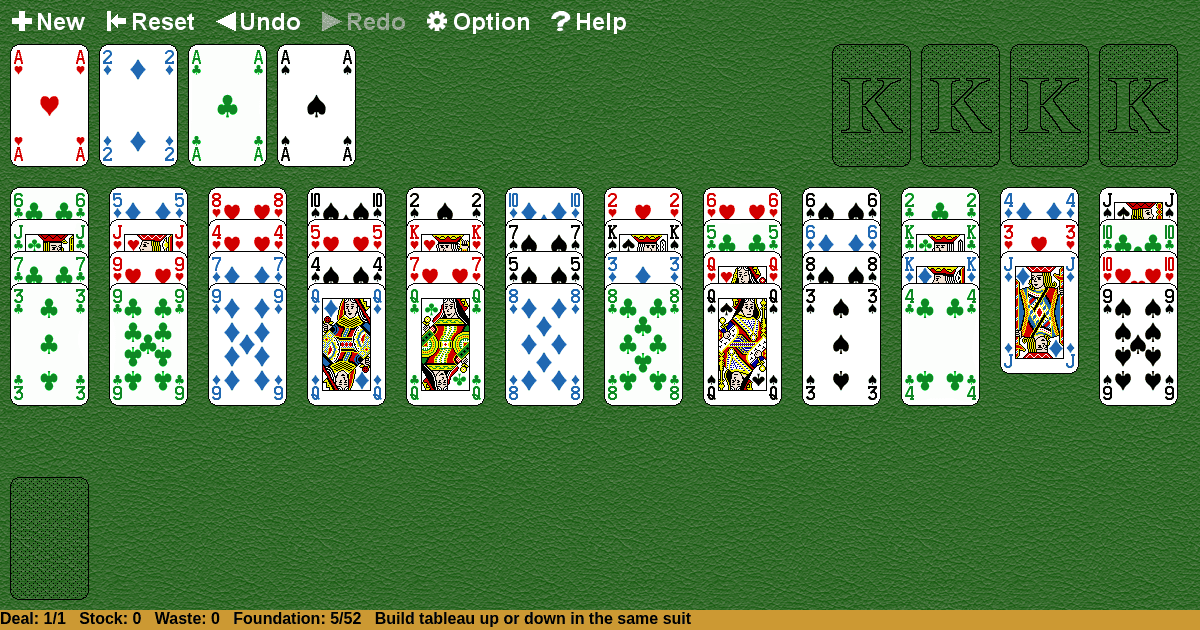Bisley
Home |
How to play |
FAQ |
About
How to play Bisley?
Game Objective:
The primary goal in Bisley Solitaire is to move all 52 cards from the tableau to the eight foundation piles, building each foundation by suit either upward from Ace or downward from King.
Setup & Layout:
- Deck Used: Standard 52-card deck.
- Foundations: Remove all four Aces from the deck and place them face up in a vertical column; these form the initial four foundations for building up by suit (Ace to King). To the left (or right, depending on source), create four additional empty foundation spaces for each suit, which will be started with Kings and built down by suit (King to Ace).
- Tableau: Shuffle the remaining 48 cards and deal them face up into 13 tableau piles:
- Four piles with three cards each.
- Nine piles with four cards each.
- Face-Up/Face-Down: All tableau cards are dealt face up; no cards are hidden.
- Play Areas Defined:
- Foundations: Eight piles (four Ace foundations, four King foundations).
- Tableau: Thirteen piles with all cards visible.
- No Stock, Reserve, or Cells: There are no additional draw piles or holding areas.
Bisley Solitaire Rules:
- Card Movement Principles:
- Only the top card of each tableau pile is available for play.
- Cards can be moved to another tableau pile or to a foundation, but only one card at a time.
- Building on Tableau:
- Build either up or down by suit (e.g., 7♦ can be placed on 6♦ or 8♦).
- Sequences are not cyclic; you cannot wrap from King to Ace or vice versa.
- Building on Foundations:
- Ace Foundations: Build up by suit, starting from Ace to King (e.g., 2♠ on Ace♠, then 3♠, etc.).
- King Foundations: Build down by suit, starting from King to Ace (e.g., Q♠ on King♠, then J♠, etc.).
- Each suit will be divided between its two foundations (Ace and King), as not all cards of a suit can fit on a single foundation.
- Moving Cards Between Foundations:
- If the top cards of both foundations of the same suit are in sequence, cards can be transferred from the King foundation to the Ace foundation to complete a suit sequence.
- Empty Tableau Piles:
- Empty tableau piles cannot be filled; once a pile is empty, it remains empty for the rest of the game.
Gameplay:
- Typical Sequence of Actions:
- Identify available moves by examining all face-up tableau cards.
- Move the top card of a tableau pile onto another tableau pile, following the build-up/down by suit rule.
- Move eligible cards from the tableau to the appropriate foundation (either Ace or King foundation, depending on rank and suit).
- Continue making moves, always observing the build direction and suit restrictions.
- No Stock or Redeal:
- There is no stock or reserve; all cards are in play from the start.
- When No More Legal Moves:
- If no further moves are possible (no cards can be legally moved to tableau or foundations), the game ends in a loss.
Winning & Losing Conditions:
- Winning Condition:
- The game is won when all 52 cards are moved to the eight foundation piles, with each suit correctly built upward from Ace and downward from King.
- Losing Condition:
- The game is lost if no more legal moves are possible and not all cards have been moved to the foundations.
Special Rules & Edge Cases:
- Filling Empty Spaces:
- Empty tableau piles cannot be filled under any circumstances; they remain empty for the duration of the game.
- Foundation Reversal:
- If the top cards of two foundations of the same suit are consecutive, cards may be transferred between the King and Ace foundations to optimize suit completion.
- Sequence Restrictions:
- Only one card can be moved at a time; sequences cannot be moved as a unit.
- Building is strictly by suit, not by alternating color or any other pattern.
- No Redeal:
- There is no redeal or recycling of cards; all cards are dealt and visible from the start.
Key Definitions:
- Foundation: A pile where cards are built up or down by suit, starting from Ace or King.
- Tableau: The main play area consisting of multiple piles where cards are built up or down by suit.
- Build Up/Down by Suit: Placing a card of the same suit that is one rank higher or lower on another card.
This guide provides the precise rules and mechanics necessary to play Bisley Solitaire correctly and efficiently.

Solitaire Collection
About Bisley
Rate (Bisley)
4.7 / 5
1,916 votes



























































